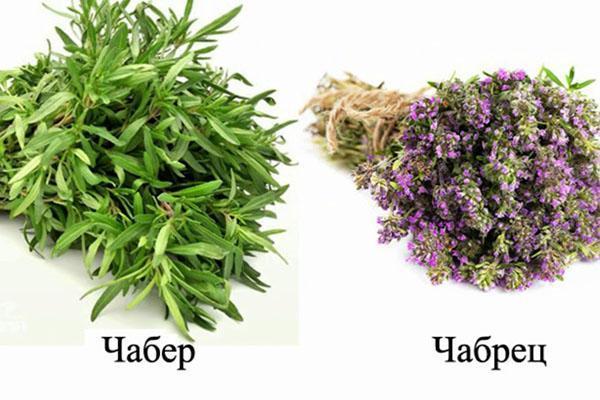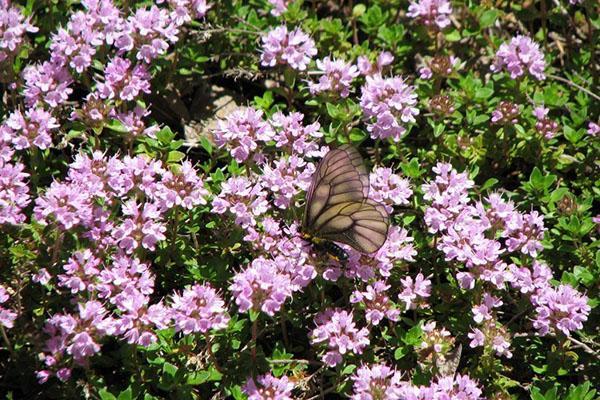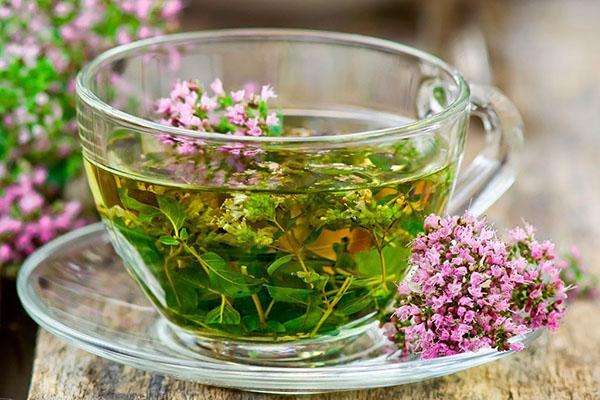What is the difference between thyme and savory
 Because of the similar names, savory and thyme are associated with the same plant, which causes confusion among lovers of spicy plants. But the difference between thyme and savory still exists. They belong to the same Yasnotkov family, but have a number of distinctive features.
Because of the similar names, savory and thyme are associated with the same plant, which causes confusion among lovers of spicy plants. But the difference between thyme and savory still exists. They belong to the same Yasnotkov family, but have a number of distinctive features.
Characteristic features of thyme

Thyme is a ground cover perennial that forms creeping or erect stems. Another name for thyme is creeping thyme. Botanical Description:
- bush height up to 30 cm;
- lignified stems;
- leaves are oval, slightly elongated, opposite;
- inflorescences are capitate, oblong;
- small flowers of pink-violet scale.
The fruits form in September and form a box with 4 nuts inside. Due to their bitter taste, they are used in cooking. Leaves and non-lignified shoot tops are collected at the beginning of flowering. The differences between savory and thyme are primarily related to their external appearance.
Garden thyme is a type of wild perennial thyme covered with white flower heads and a characteristic odor. It is a well-known spice plant that blooms throughout the summer to form a bright and aromatic carpet.
Composition and use in medicine
 The chemical composition includes a high% of essential oils, vitamin C, flavonoids, carotene or provitamin A, tannins and organic acids, saponins, biologically active compounds. There is also a complex of minerals: magnesium, calcium, potassium.
The chemical composition includes a high% of essential oils, vitamin C, flavonoids, carotene or provitamin A, tannins and organic acids, saponins, biologically active compounds. There is also a complex of minerals: magnesium, calcium, potassium.
Doctors have long "adopted" the herb. Thyme is useful as an expectorant, antibacterial agent and is used in treating the common cold of a bacterial nature. This is a good antispasmodic with an analgesic effect. Thyme tea has soothing properties, which is beneficial in our stressful lives.
Cooking use
 The difference between thyme and savory extends to the culinary field as well. Due to the presence of essential oils in the composition, these are popular spices with different aromas. Thyme has a pungent and strong odor and a spicy, bitter taste. Both fresh and dried leaves of the plant are used as a seasoning for dishes.
The difference between thyme and savory extends to the culinary field as well. Due to the presence of essential oils in the composition, these are popular spices with different aromas. Thyme has a pungent and strong odor and a spicy, bitter taste. Both fresh and dried leaves of the plant are used as a seasoning for dishes.
Thanks to the presence of thyme in dishes, their taste is enriched, an additional aroma with a hint of bitterness arises. This is a seasoning for salads, main courses, marinades, sauces. Lovers of this spicy scent add a dry pick to flavor tea.
Spicy thyme leaves are introduced into the dish at the initial stages of its preparation, and savory - before readiness. Thyme is a useful condiment for fatty foods, which helps its absorption without causing discomfort.
Garden decoration
Due to the compactness of the bushes that do not grow in breadth, thyme used in garden design. And although single plants are not particularly decorative, their mass planting looks interesting.
Thyme is planted:
- as a carpet and soil-covering plant in open spaces;
- in rockery as an additional color spot;
- along the edge of the flower garden, giving it finished forms;
- along garden paths or massively - to strengthen the slope.
An unpretentious plant fills any free areas and its undemandingness to growing conditions pleases flower growers, helping to arrange a site without much hassle.
Savory features

What is this savory and how does it differ from thyme? Savory or pepper grass is a herbaceous annual plant. Its appearance is distinguished by the following features:
- height 40-50 cm;
- linear leaves with a grayish tint;
- straight, slightly branched stem;
- the arrangement of flowers in the axils of the whorls;
- flowers from white to lilac.
Flowering occurs from July to August, and brown nuts are formed in September. Savory is harvested for medicinal and culinary purposes at the end of flowering.
Composition and healing effect
The main component of savory is essential oil, which gives the plant a tart, balsamic aroma. The vitamin composition includes carotene and vitamin C. The presence of phytoncides determines the antibacterial properties of the herb, and tannins have an astringent effect. The plant is rich in minerals.
The difference between thyme and savory lies in the beneficial properties of infusions and for savory they are as follows:
- destroys ectoparasites;
- cleans the blood by removing toxic compounds;
- cleans kidneys and liver from toxins;
- normalizes blood sugar levels;
- helps with tachycardia and other heart problems.
It is an antiseptic, antispasmodic, diuretic and anesthetic herb "in one bottle". It has an expectorant and diaphoretic effect that relieves cold symptoms.
If an insect has bitten, then a savory leaf should be tied to the wound site, which will relieve pain and remove swelling.
Addition to cooking dishes
 The use in cooking is associated with the special bright aroma of savory and its hot pepper taste, which organically fits into vegetable and fish dishes, giving spicy and pungent notes to confectionery products. Dried seasoning seasoned rabbit meat, poultry, beef.
The use in cooking is associated with the special bright aroma of savory and its hot pepper taste, which organically fits into vegetable and fish dishes, giving spicy and pungent notes to confectionery products. Dried seasoning seasoned rabbit meat, poultry, beef.
Greens are used fresh, as well as dry, salted or pickled. In any form, it retains its taste.
Savory is not a common ornamental plant; it is usually grown in medicinal gardens or spicy beds.
Sometimes the plant is used as a curb, which is planted along the edges of paths, alleys, paths.
Similarities and differences between thyme and savory
 Two plants that are consonant by name have some similarities. It is associated not only with the names, but also with the purpose: savory and thyme are classified as spicy herbs. They are found in nature and take root well in summer cottages. Appreciated primarily for aroma, and then for decorativeness. These are excellent honey plants. Due to the large spectrum of useful substances, they are used for medical purposes. And given their belonging to all Yasnotkovs, it is quite easy to confuse them.
Two plants that are consonant by name have some similarities. It is associated not only with the names, but also with the purpose: savory and thyme are classified as spicy herbs. They are found in nature and take root well in summer cottages. Appreciated primarily for aroma, and then for decorativeness. These are excellent honey plants. Due to the large spectrum of useful substances, they are used for medical purposes. And given their belonging to all Yasnotkovs, it is quite easy to confuse them.
Plants have different origins. Thyme in Ancient Egypt was an important component in the embalming of the corpses of important persons. And the inhabitants of Ancient Greece added savory to their food as a seasoning.
What is the difference between savory and thyme from a botanical point of view? The appearance of the plants is significantly different, as can be seen from the photo and description. Savory is distinguished by its height and bush shape, while thyme is a shorter and more flowering shrub. Thyme spreads along the ground to form a floral carpet. The shape of leaves, flowers, their arrangement is also different.
Savory has a sharper and richer smell, while thyme has light and fresh shades, which implies the use of these spices in the preparation of various dishes, experimenting and finding new and interesting combinations of products and herbs.
Both plants are rich in essential oils and are widely used in cooking. They have a pronounced bactericidal effect, which makes it possible to use them as an additional agent in the treatment of infections.
Now that the difference between savory and savory is clear, it is not difficult to plant them on your site, part of which is set aside for the "medicinal garden".They will always be at hand and will not only be included in the daily menu and will be an addition to your favorite dishes, but will also help as a folk remedy in the fight against a number of ailments, while remaining on the guard of health and longevity.